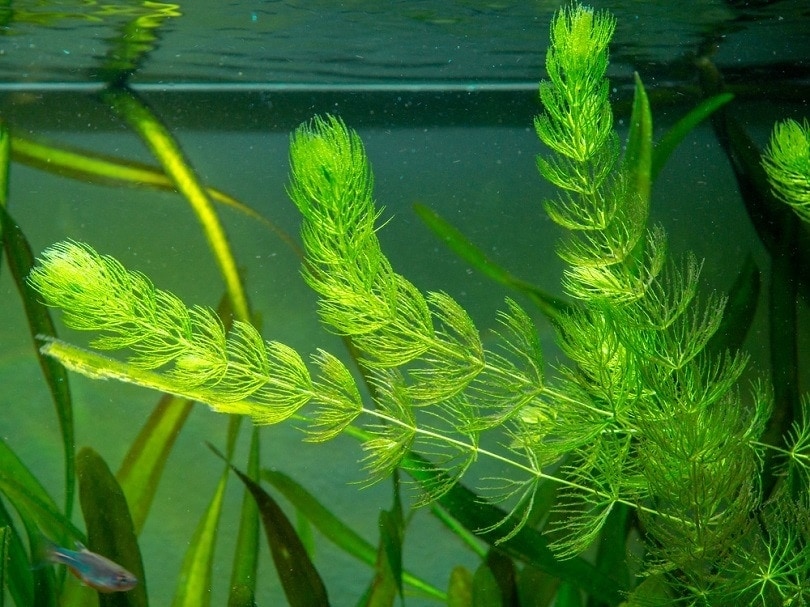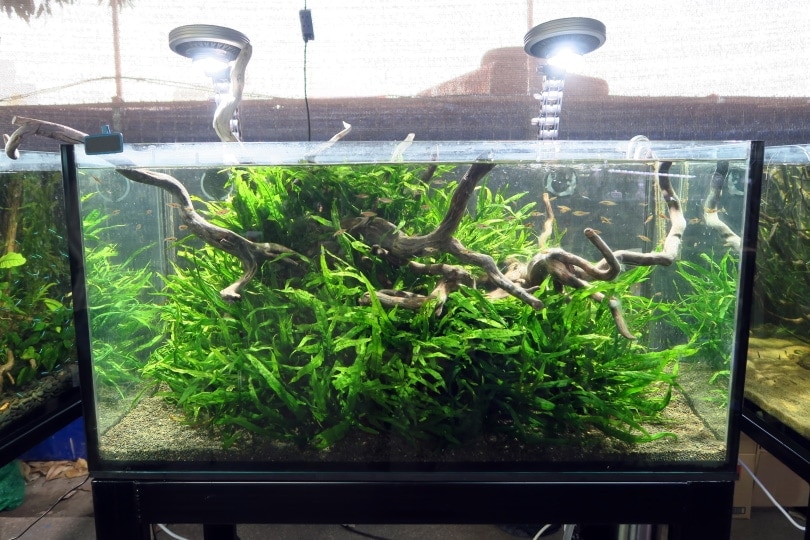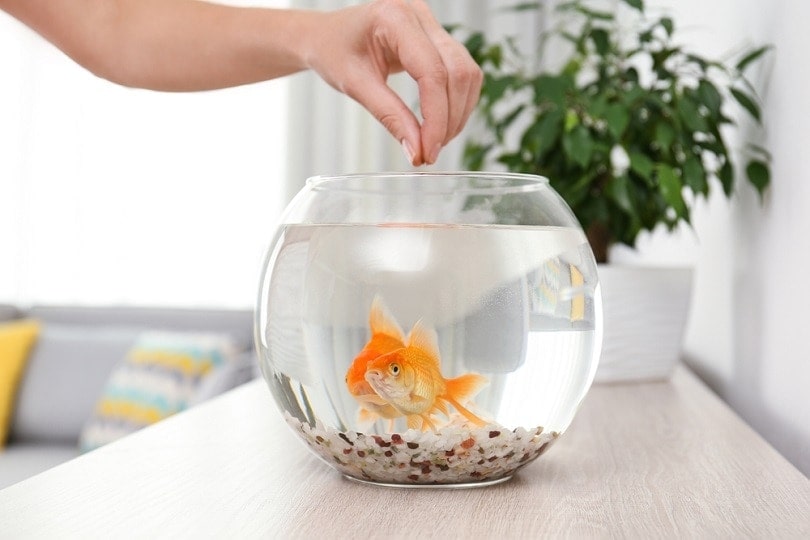Hornwort Aquarium Plant: Complete Care Guide (Planting & Growing)

Updated on

Looking for a beautiful, easy-to-grow, low-maintenance, and hardy aquarium plant? Hornwort is just that! Today we’re going to give you the lowdown on this plant that is perfect for a wide range of species…
… From goldfish to shrimp—and beyond.
Keep reading to learn more!
Hornwort Plant Overview
Hornwort is also known as “Coontail” or “coon’s tail.” Ceratophyllum is the scientific name, with Ceratophyllum demersum being the most common (as well as the most hardy) species.
It is native to North American waters. Interestingly enough, in New Zealand, it is declared an invasive species due to its ability to take over and out-compete native plants. It has bright green feathery leaves —or needles—that grow in whorls of between 6 and 12 needles each. These leaves stay short, but the plant itself can grow very tall.
The stems can reach a whopping 10 feet in length! Due to its long size, it’s a great choice as a background plant in your aquarium. As such, it can be useful for hiding equipment and creating a natural “jungle” type effect.
Where to Find it
You can find Hornwort from certain dealers in the aquarium industry, and at some fish stores. I got mine online from Amazon here.
They give you a good hearty portion and have great customer service. The plant is obviously well cared for and happy, as seen from the compact needle placement and copper-hued tips.
At certain times of the day—with enough light—you can see tiny little trails of bubbles coming out of this plant as it oxygenates the water.
General Care
Hornwort is not a very demanding plant and is excellent for beginners. (You almost have to be trying to kill this plant for it to die.) In fact, the only continent where you can’t find it is Antarctica. It does not require CO2 injections, high lighting, or fertilizers (though it will benefit from both of these).
Plus, propagation couldn’t be easier. The main plant grows several little side shoots that turn into bigger plants. You only have to snip off one of these side shoots and leave it floating with the rest.
This little shoot will grow into its own entire plant!
Hornwort is very, VERY hardy. This makes it a perfect plant for fish like goldfish, who are notoriously abusive to most live plants.
Planting Tips
Hornwort has some special requirements when it comes to planting.
WARNING: If you plant the bottom of the stem in the substrate, it can rot!
This is because unlike other stem plants such as Cabomba, it does not grow roots. Instead, you should leave it floating or anchor it with lead weights/string. I prefer these aquarium-safe lead weights.
Floating is pretty straightforward—simply throw it in the tank and call it done. Getting it to weigh down with string and rocks or wood can take some finagling, but might be more along the lines of your desired aesthetic effect. Any kind of trapping the root (such as underneath a rock) again can cause the roots to rot.
Some also use suction cups and nylon string or airline tubing to fix it to the glass near the bottom of the tank to hold it in place. You might also be able to use plant glue to anchor it to a rock.
Lighting
It thrives best in moderate light conditions. The higher the light, the bushier the plant will get. Not enough light and the plant will get “stemmy”—it’s trying to grow too tall to get to the light!
That said, Hornwort may start to turn yellow when exposed to light that is too strong. But low light will cause it to grow slowly. More rapid growth rates will require more frequent pruning.

Temperature & Water Conditions
Want to know one really nice secret about Hornwort? It’s INCREDIBLY flexible when it comes to temperature requirements. In fact, it’s the only readily available plant I know of that can survive winter outdoors in a pond!
That’s because it can tolerate very low temperatures. If kept outside over winter, it will probably drop all of its needles. These can grow back once it warms up in the spring. But it also does just fine in warm temperatures as well—even up to the high 80 degrees F!
As far as pH goes, this plant is flexible in that respect as well. It does well in either acidic or alkaline waters.
The 5 Benefits Hornwort Offers Your Aquarium
1. Algae Inhibitor
Hornwort can be very useful when it comes to controlling algae. It has allelopathic abilities…
… Meaning it produces special chemicals that fight against competing plants (especially algae).
This helps it to “take over” the aquarium where you put it. Many aquarists will routinely toss in a clump of hornwort whenever they start a new tank to help prevent algae outbreaks during cycling and beyond.
If they decide not to keep it, they put it in a glass jar with some rocks for a beautiful table centerpiece!
2. Breeding & Fry Tanks
Hornwort is a VERY popular choice for fish breeders of all species, goldfish included. The reason? It provides critical shelter for eggs and baby fish from other fish. It also provides tiny particles of food for the babies.
And it purifies the water as it grows quickly, keeping the living conditions pristine for sensitive fry. Spawning fish can use it as protection from stress.

3. Nitrate Buster & Nutrient Vacuum
Hornwort literally grows like a weed. And fast-growing plants are the most efficient at sucking up nitrate from the water! If you struggle with high nitrates, Hornwort might be a plant worth considering.
After all…
… It might make your life easier by reducing the need for water changes.
4. Water Oxygenation
Not only does this plant take up excess nutrients from the water, helping make your tank’s environment healthier. It also puts out oxygen into the water!
And it does so better than most plants due to its fast-growing capabilities. This is especially useful for heavily stocked tanks or fry grow-out tanks.
5. Hardiness
Want to know another thing that makes Hornwort such a great aquarium plant? It’s SUPER hardy! It’s doubtful even goldfish will be able to much it down. Even if they do (which I have yet to see or hear of) It’s such a fast grower that they will likely never be able to eradicate it.

Needle Shedding Concerns
Some fishkeepers find that this plant sheds its thin leaves much like an old Christmas tree sheds its needles, and this has led to the stigma of Hornwort being a “messy” plant. This has led to statements such as:
“I wouldn’t wish this plant on my worst enemy!” But don’t worry:
This is a temporary issue. The reason for this is that it is adjusting to the new water conditions in your aquarium, which may be quite different than the water it was used to. Hornwort can tolerate a wide variety of water conditions, but it needs to adapt if it is transferred to somewhere that is a good bit different.
The acclimation process can take up to 4 weeks, and then this will stop once it settles in and it will start showing new growth. It is well worth the extra initial maintenance of vacuuming these needles up with your siphon until it fully adjusts!
Also:
If you don’t want to deal with this and don’t mind a plant that likes warmer water, Myrio Green could be a better option for your tank.
Snails
Most commercially available hornwort is grown in ponds or nurseries where little snails may find their way to this plant. Usually, they are bladder and ramshorn snails, both quite harmless. It is easy to get rid of these snails if you want…
… But I prefer to keep them as they help break down waste in the tank and – more importantly – they keep debris and diatoms from building up on the needles of the plant and suffocating it. They will only multiply to out-of-control levels if there are too many excess nutrients in your aquarium.
Not everyone wants them. So if you still say no to “pest” snails, I wrote this post on how to get rid of snails when quarantining your plants.

Final Thoughts
I really find Hornwort to be a useful plant with so many applications in the aquarium hobby. What about you? Have you ever tried to grow this plant in your tank? What has your experience been?
Let me know when you leave your comment in the section below!
See Also:
Featured image credit: Joan Carles Juarez, Shutterstock












